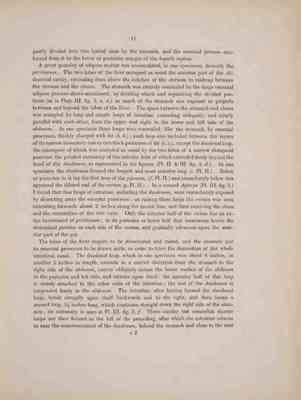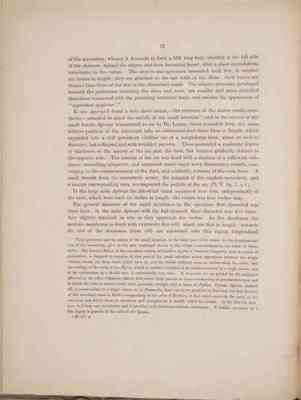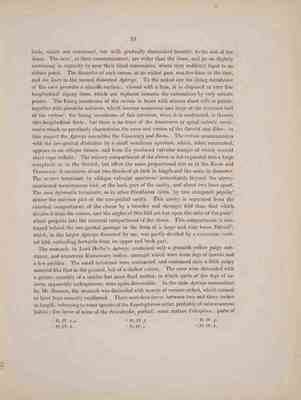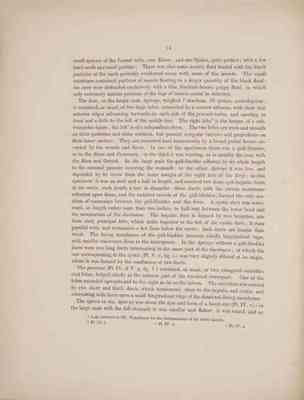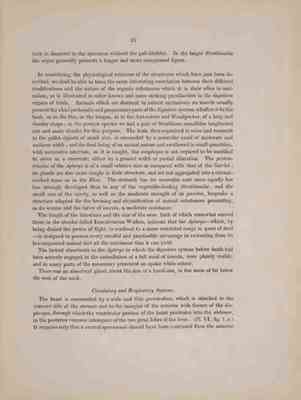Pages
31
11
partly divided into two lateral ones by the stomach, and the omental process continued from it to the lower or posterior margin of the hapatic septum.
A great quantity of adipose matter was accumulated, in one specimen, beneath the peritoneum. The two lobes of the liver occupied as usual the anterior part of the abdominal cavity, extending from above the notches of the sternum to midway between the sternum and the cloaca. the stomach was entirely concealed by the large omental adipose process above-mentioned, by dividing which and separating the divided portions (as in Plate III.fig.3, a,a,) as much of the stomach was exposed as projects between and beyond the lobes of the liver. The space between the stomach and cloaca was occupied by long and simple loops of intestine, extending obliquely, and nearly parallel with each other, from the upper and right to the lower and left side of the abdomen. In one specimen these loops were concealed, like the stomach, by omenral processes, thickly charged with fat (b,b,) ; each loop also included between the duodenal loop, the interspace of which was occupied as usual by the two lobes of a narrow elongated pacreas, the pointed extremity of the anterior lobe of which extended freely beyond the bend of the duodenum , as represented in the figures (Pl.II & III, fig.3,d.). In one specimen the duodenum formed the longest and most anterior loop (e,Pl.II.). Below or posterior to it lay the first loop of the jejunum, (f,Pl.II.) and immediately below this appeared the dilated end of the rectum (g.Pl.II.). In a second Apteryx (Pl. III.fig.3) I found that four loops of intestine, includin the duodenum, were immediately exposed by dissecting away the omental processes : on raising these loops the rectum was seen extending forwards about 2 inches along the mesial line, and then receiving the ileum and the extremities of the two caeca. Only the anterior half of the rectum has an entire investment of peritoneum ; at its posterior or lower half that membrane leaves the abdominal parietes on each side of the rectum, and gradually advances upon the anterior part of the gut.
The lobes of the liver require to be divaricated and raised, and the stomach and its omental processes to be drawn aside, in order to trace te disposition of the whole intestinal canal. the duodenal loop, which in one specimen was about 4 inches, in another 5 inches in length, extends in a curved direction from the stomach to the right side of the abdomen, curves obliquely across the lower surface of the abdomen to the posterior and left side, and returns upon itself : the rest of the duodenum is suspended freely in the abdomen. the intestine, after having formed the duodenal loop, bends abruptly upon itself backwards and to the right, and then forms a second loop, 3 1/2 inches long, which continues straight down the right side of the abdomen ; its extremity is seen at Pl. III.fig.3,f. Three similar but somewhat shorter loops are then formed to the left of the preceding, after which the intestine returns to near the commencement of the duodenum, behind the stomach and close to the root
c2
32
12
of the mesentery, whence it descends to form a fifth long loop, situated at the left side of the abdomen, behind the others, and then becoming looser, after a short convolution, terminates in the rectum. The coeca in one specimen measured each five, in another six inches in length ; they are attached to the last folds of the ileum : their tunics are thinner than those of the rest of the alimentary canal. The adipose processes developed beneath the peritoneum investing the ileum and coeca, are smaller and more detached than those connected with the preceding intestinal loops. and assume the appearance of "appendices epiloicoe 1."
In one Apteryx I found a very short coecum, - the remnant of the ductus vitello-intestinalis, - attached to about the middle of the small intestine 2 ; and in the viscera of the small female Apteryx transmitted to me by Dr. Logan, there extended from the same relative position of the intestinal tube an obliterated duct three lines in length, which expanded into a still persistent vitelline sac of a subglobular form. about an inch in diameter, but collapsed and with wrinkled parietes. These presented a moderate degree of thickness in the moiety of the sac next the duct, but became gradually thinner to the opposite side. the interior of the sac was lined with a stratum of a yellowish substance resembling adipocere, and contained many small wavy filamentary vessels, converging to the commencement of the duct, and evidently remains of the vasa lutea. A small branch from the mesenteric artery, the remnant of the omphalo-mesenteric, and a minute corresponding vein, accompanied the pedicle of the sac (Pl. V. fig.1,s,t.).
In the large male Apteryx the intestinal canal measured four feet, independently of the coeca, which were each six inches in length : the rectum was four inches long.
The general diameter of the small intestines in the specimen first dissected was three lines ; in the male Apteryx with the full stomach their diameter was five lines : they slightly diminish in size as they approach the rectum. In the duodenum the mucous membrane is beset with extremely fine villi, about one line in length ; towards the end of the duodenum these villi are converted into thin zigzag longitudinal
1 These processes and the return of the small intestine, in the latter part of its course, to the duodenum and root of the mesentery, give to the part continued thence to the rectum a resemblance to the colon in Mammalia. The learned Editor of the excellent edition of Cuvier's Lecons d'Anatomie comparee, now in course of publication, is disposed to consider all that part of the small intestine which intervenes between the single vitelline coecum (in those birds which have it) and the double ordinary coeca, as represnting the colon : and the analogy of the colon of the Hyrax, which is similarly bounded at its commencement by a single coecum, and at its termination by a double one, is undoubtedly very close. If, however, we are guided by the analogies afforded by the other oviparous classes, with which birds present so close a conformity of general structure, and in which the colon is always short, wide , generally straight, and in some, as Python, Testudo, Iguana, marked off, or commencing by a single coecum, as in Mammalia, there can be no question in that case but that the part of the intestinal canal in Birds corresponding to the colon of Reptiles, is that which succeeds the entry of the two coeca, and which, from its shortness and straightness, is usually called the rectum. In the Ostrich, however, it is long and convoluted, and is provided with transverse valvuloe conniventes. A similar structure in a less degree is present in the colon of the Iguana.
1 Pl. IV.d.
33
13
folds, which are continued, but with gradually diminished breadth, to the end of the ileum. The coeca 1, at their commencement, are wider than the ileum, and go on slightly increasing in capacity to near their blind extremities, where they suddenly taper to an obtuse point. The diameter of each coecum, at its widest part, was five lines in the first, and six lines in the second dissected Apteryx. To the naked eye the lining membrane of coeca presents a smooth surface ; viewed with a lens, it is disposed in very fine longitudinal zigzag lines, which are replaced towards the extremities by very minute points. the lining membrane of the rectum is beset with minute short villi or points, together with glandulae solitariae, which become numerous and large at the terminal half of the rectum 2: the lining membrane of this intestine, when it is contracted, is thrown into longitudinal folds ; but there is no trace of the transverse or spiral valvula conniventes which so peculiarly characterize the coeca and rectum of the Ostrich and Rhea : in this respect the Apteryx resembles the Cassowary and Emeu. the rectum communicates with the uro-genital dilatation by a small semilunar aperture, which, when contracted, appears as an oblique fissure, and from the produced valvular margin of which several short rugae radiate. the urinary compartment of the cloaca is not expanded into a large receptacle as in the Ostrich, but offers the same proportional size as in the Emeu and Cassowary : it measures about two-thirds of an inch in length and the same in diameter. The ureters terminate by oblique valvular apertures 3 immediately beyond the abovementioned membranous fold, at the back part of the cavity, and about two lines apart. the vasa deferentia terminate, as in other Struthious birds, by two elongated papilloe 4 nearer the anterior part of the uro-genital cavity. This cavity is separated from the external compartment of the cloaca by a broader and stronger fold than that which divides it from the rectum, and the angles of this fold are lost upon the sides of the penis 5, which projects into the external compartment of the cloaca. This compartment is continued behind the uro-genital passage in the form of a large and wide bursa Fabricii 6, which, in the larger Apteryx dissected by me, was partly divided by a crescentic vertical fold, extending forwards from its upper and back part.
The stomach, in Lord Derby's Apteryx, contained only a greenish-yellow pulpy substance, and numerous filamentary bodies, amongst which were some legs of insects and a few pebbles. The small intestines were contracted, and contained only a little pulpy material like that in the gizzard, but of a darker colour. the coeca were distended with a greater quantity of a similar but more fluid matter, in which parts of the legs of insects, apparently orthopterous, were again discernible. In the male Apteryx transmitted by Mr. bennett, the stomach was distended with insects of various orders, which seemed to have been recently swallowed. There were four larvae, between two and three inches in length, belonging to some species of the Lepidopterous order, probably of subterraneous habits ; five larvae of some of the Scarabeidoe, perfect ; some mature Coleoptera ; parts of
1. Pl. IV.e.e. 2. Pl. IV. f. 3. Pl. IV. g. 4. Pl. IV. h. 5. Pl. IV. i. 6. Pl. IV. k
34
14
small species of the Locust tribe ; one Elater ; and one Spider, quite perfect ; with a few hard seeds and small pebbles 1. There was also some muddy fluid loaded with the black particles of the earth probably swallowed along with some of the insects. The small intestines contained portions of insects floating in a larger quantity of the black fluid : the caeca were distended exclusively with a thin blackish-brown pulpy fluid, in which only extremely minute portions of the legs of insects could be detected.
The liver, in the larger male Apteryx, weighed 7 drachms, 35 grains, avoirdupoise ; it consisted, as usual, of two large lobes, connected by a narrow isthmus, with their thin anterior edges advancing forwards on each side of the proventriculus, and meeting in front and a little to the left of the middle line. The right lobe 2 is the longer, of a subtriangular figure ; the left 3 is of a subquadrate form. the two lobes are even and smooth on their posterior and outer surtaces, but present irregular furrows and projections on their inner surface. They are traversed here transversely by a broad portal fissure occupied by the vessels and ducts. In two of the specimens there was a gall-bladder, as in the Emeu and Cassowary ; in the third it was wanting, as is usually the case with the Rhea and Ostrich. In the large male the gall-bladder adhered by is whole length to the omental process covering the stomach ; in the other Apteryx it was free, and depended by its cervix from the inner margin of the right lobe of the liver ; in this specimen 4 it was an inch and a half in length, and received two short cyst-hepatic ducts at its cervix, each nearly a line in diameter : these ducts, with the serous membrane reflected upon them, and the nutrient vessels of the gall-bladder, formed the only medium of connexion between the gall-bladder and the liver. A cystic duct was continued, in length rather more than two inches, to hald-way between the lower bend and the termination of the duodenum. the hepatic duct is formed by two branches, one from each principal lobe, which unite together to the left of the cystic duct ; it runs parallel with, and terminates a few lines below the systic : both ducts are longer than usual. the lining membrane of the gall-bladder presents chiefly longitudinal rugae, with smaller transverse lines in the interspaces. In the Apteryx without a gall-bladder there were two long ducts terminating in the same part of the duodenum ; of which the one corresponding to the systic (Pl. V.o,fig.1.) was very slightly dilated at its origin, where it was formed by the confluence of two ducts.
The pancreas (Pl.IV. & V. q, fig 1.) consisted, as usual, of two elongated subtrihedral lobes, lodged chiefly in the anterior part of the duodenal interspace. One of the lobes extended upwards and to the right as far as the spleen. The secretion was carried by two short and thick ducts, which terminated, close to the hepatic and cystic, and alternating with them upon a small longitudinal ridge of the duodenal lining membrane.
The spleen in one Apteryx was about the size and form of a hazel-nut (PL.IV.r,) : in the large male wiht the full stomach it was smaller and flatter : it was round, and an
1. I am indebted to Mr. waterhouse for the determination of the above insects. 2. Pl.IV. l. 3. Pl. IV. m 4. Pl. IV. n.
35
15
inch in diameter in the specimen without the gall-bladder. In the larger Struthionidoe the organ generally presents a longer and more compressed figure
In considering the physiological relations of the structures which have just been described, we shall be able to trace the same interesting correlation between their different modifications and the nature of the organic subsances which it is their office to assimilate, as is illustrated in other known and more striking pecularities in the digestive organs of birds. Animals which are destined to subsist exclusively on insects usually present the chief prehensile and preparatory parts of the digestive system, whether it be the beak, as in the Ibis, or the tongue, as in the Ant-eaters and Woodpecker, of a long and slender shape ; in the present species we find a pair of Struthious mandibles lengthened out and made slender for this purpose. The beak, thus organized to seize and transmit to the gullet objects of small size, is succeeded by a muscular canal of moderate and uniform width ; and the food being of an animal nature and swallowed in small quantities, with successive intervals, as it is caught, the aesophagus is not required to be modified to serve as a reservoir, either by a general width or a partial dilatation. The proventriculus of the Apteryx is of a small relative size as compared with that of the Ostrich ; its glands are also more simple in their structure, and are not aggregated into a circumscribed mass as in the Rhea. the stomach has its muscular coat more equally but less srongly developed than in any of the vegetable-feeding Struthionidoe ; and the small size of the cavity, as well as the moderate strength of its parietes, bespeaks a structure adapted for the bruising and chymification of animal substances presenting, as do worms and the larvae of insects, a moderate resistance.
The length of the intestines and the size of the coeca, both of which somewhat exceed those in the slender-billed Insectivorous Waders, indicate that the Apteryx - which, by being denied the power of flight, is confined to a more restricted range in quest of food - is designed to possess every needful and practicable advantage in extracting from its low-organized animal diet all the nutrient that it can yield.
The lacteal absorbents in the Apteryx in which the digestive system before death had been actively engaged in the assimilation of a full meal of insects, were plainly visible, and in many parts of the mesentery presented an opake white colour.
There was an absorbent gland, about the size of a hazel-nut, in the mass of fat below the root of the neck.
Circulatory and Respiratory Systems.
The heart is surrounded by a wide and thin pericardium, which is attached to the concave side of the sternum and to the margins of the anterior wide fissure of the diaphragm, through which the ventricular portion of the heart protrudes into the abdomen, in the posterior concave interspace of the two great lobes of the liver. (Pl. VI., fig.1,a.) It requires only that a central aponeurosis should have been continues from the anterior
